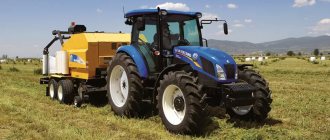Fuel consumption standards for tractors
Proper calculation of diesel fuel consumption on tractors allows companies that own special equipment to save on fuels and lubricants and maintaining their fleet.
The specific fuel consumption of tractors is indicated in the instructions. To perform calculations, different manufacturers use their own formulas. It must be understood that these calculations are carried out taking into account the fact that the tractor is operated in “ideal” conditions, that is, on a flat road, without the influence of atmospheric phenomena, etc. For each tractor model, fuel consumption per hour is determined individually; it depends on the operating conditions of the vehicle.
Reasons for increasing/decreasing fuel consumption
More or less consumption, compared to the norm, depends on various reasons. The main one: the technical condition of the engine. Features of operation, average speed, load capacity, precipitation, and road surface are also taken into account. The latter is divided into 3 types:
- hard (soil, compacted snow);
- gravel, sand (medium hard soil);
- wet (arable land, snow-covered virgin soil, off-road).
How to calculate real gas mileage #1 auto tips. Calculation formula
The issue of accurate calculation is especially important for vehicle drivers working far from qualified assistance in forest areas, facilities under construction, and extreme recreation. For a simple car owner, it will be enough to determine the average and instant fuel consumption, while for professionals, including accountants of enterprises that own vehicles, the specific rate of fuel consumption, as well as the rate of its consumption under various operating conditions, will be more interesting.
Features of calculating fuel consumption
To measure the indicator, the tractor needs to travel a distance of 100 kilometers. Based on this, the amount of fuel consumed is measured.
Before taking measurements, you need to check the condition of the main components and assemblies of the transport.
Calculation of fuel consumption rates for tractors is carried out using the formula: P=0.7*R*N.
Where R is specific fuel consumption, N is engine power, 0.7 is a constant coefficient for conversion from kW, P is fuel consumption in 60 minutes.
The correction for carrying capacity is calculated by an additional factor from 0.5 to 1, depending on the load.
Dependence of consumption on tractor model
The table below shows fuel consumption standards for tractors MTZ BELARUS, YuMZ, John Deere.
| tractor del | Fuel consumption |
| MTZ-80 | 5.5 l/hour |
| MTZ-82.1 | 5.5 l/hour |
| BELARUS-320 | 3.0 l/hour |
| BELARUS-1221 | 3.1 l/hour |
| YuMZ-6G | 5.8 l/hour |
Below are fuel consumption data for powerful John Deere models.
| Tractor model | Fuel consumption |
| 56 l/hour | |
| 60.2 l/hour | |
| 65 l/hour | |
| 67.4 l/hour | |
| 54.9 l/hour | |
| 56.4 l/hour | |
| 58.9 l/hour | |
| 63.2 l/hour |
| Brand, model) | additional characteristics | Basic rate, kg/hour |
| Tractors and crawler tractors | ||
| ATS-59 | V-1 (370 kW) | 54,1 |
| ATS-59 | V2-450 (330 kW) | 48,4 |
| ATS-59 | A-650G (220 kW) | 32,2 |
| GAZ-71 | D-240 (55.2 kW) | 8,1 |
| GAZ-34041 (conveyor-tractor) | D-240 | 6,0 |
| DT-10P | V-46-5 (525 kW) | 76,8 |
| DT-54/DT-54V/DT-54M | 4,5 | |
| DET-250 | 20,9 | |
| T-100/S-100 (all modifications) | 7,2 | |
| T-130 | D-160 (122.8 kW) | 13,7 |
| T-130/T-130BG | D-130 (102.9 kW) | 10,5 |
| T-170 | D-160 | 14,2 |
| T-180 | 10,5 | |
| T-330 | 22,0 | |
| T-38 (M)/T-50V/ TDT-40 (M) | 4,1 | |
| T-4/TT-4 | 7,6 | |
| T-74 (S)/DT-75 (S)/ TDT-55 | 6,3 | |
| T-150 | 11,4 | |
| Wheeled tractors | ||
| DT-20 (T-20)/DT-21/T-25 (A) | 1,8 | |
| K-700 | YaMZ-8424 (243 kW) | 22,7 |
| K-700 (A) | YaMZ-238ND (162 kW) | 13,9 |
| K-701 | YaMZ-240B (220 kW) | 17,5 |
| K-701 | YaMZ-240NM (368 kW) | 30,1 |
| MTZ-5 (all modifications) | 4,1 | |
| MTZ-50/MTZ-52 (all modifications) | 4,4 | |
| MTZ-80/MTZ-82 (all modifications) | 5,0 | |
| T-150K | 11,4 | |
| T-16 (M) | 1,8 | |
| T-23M/T-28/T-40 (A) | 3,1 | |
| T-25 | D-120 (23.5 kW) | 2,5 |
| T-40 | D-37 (29.4 kW) | 3,7 |
| T-40 | D-144 (46.5 kW) | 5,5 |
| YuMZ-6 | D-65N | 7,4 |
Calculation of fuel consumption of a diesel forklift When purchasing a diesel forklift, the buyer may be interested in the fuel consumption of the forklift. This is due to the fact that the loader must be put on the balance sheet, fuel must be written off according to standards, and the cost of work and goods must be calculated. Manufacturers in the technical characteristics of diesel forklifts indicate “specific fuel consumption,” which is measured in grams per unit of power (hp or kW). The maximum theoretical fuel consumption can be calculated using the formula: Q=N*q where: N is engine power; q—specific fuel consumption; Q is the maximum theoretical fuel consumption in grams per 1 hour of engine operation at maximum power. For example, if the technical characteristics of the loader included the following parameters: Rated engine power, kW. (hp), not less: 59 (80) Specific fuel consumption g/kW. h (g/hp h) no more than: 265 (195) then in 1 hour of operation the loader would consume 265*59=15635 grams of fuel. When calculating actual fuel consumption, two amendments need to be taken into account: 1. the loader engine does not work all the time at maximum speed with maximum power, 2. fuel is usually recorded in liters, not grams. Therefore, to calculate the actual fuel consumption of a forklift, you should use the improved formula: Q = Nq/(1000*R*k1), where q is the specific fuel consumption; N - power, hp (kW); R is the density of diesel fuel (0.85 kg/dm3); k1 is a coefficient characterizing the percentage of operating time at maximum engine speed; Q - fuel consumption in liters per hour. Since in practice the forklift is not loaded to its maximum during the shift, the forklift engine does not operate at its maximum power all the time, but the power varies depending on the load. Hence the need arises to apply a coefficient that would take into account the ratio of the engine operating time at maximum speed to the engine operating time at minimum speed. If there is no reliable data on the operation of the loader, it is assumed that out of 100% of the working time, only 30% of the machine operates at maximum speed, so k1 will be equal to 70%: 30% = 2.33. An example of calculating fuel consumption in liters per hour for the D3900 engine. q=265 g/kWh; N - 59 kW; R -0.85 kg/dm3; k1 - 2.33; Q = N*q/(1000*R*k1) = 59*265:(1000*0.85*2.33)=7.9 l/hour. In reality, theoretical calculations of diesel fuel consumption will always be slightly higher than in practice, since in real conditions the loader works less and the load on the engine is correspondingly less than in test conditions. According to our statistics, fuel consumption for the D3900 engine ranges from 4.5 l/hour to 7.5 l/hour, depending on the load.
Rules for drawing up the act
The act can be drawn up on the organization’s letterhead or on an ordinary A4 sheet - this does not matter, nor does it matter whether it is handwritten or printed on a computer.
There is one immutable condition: it must contain the original signatures of the persons responsible for the write-off.
It is also not necessary to put a seal on the act, since since 2016 legal entities have been exempted from the need to use seals and stamps in their activities.
After drawing up an act on the write-off of fuel and lubricants and its acceptance in the accounting and tax records of the company, the document is transferred for storage to the archive of the enterprise, where it must be kept for the period established by law.
Factors affecting tractor fuel consumption
Excessive fuel consumption (or less than expected fuel consumption) can be caused by several factors. For example, one of the main reasons is the technical condition of the tractor power unit. Experts advise checking the internal combustion engine for problems before starting work.
Photo source: exkavator.ru/trade Fuel consumption is determined by a number of different factors
The indicator is also affected by the operator's driving style (aggressive driving, incorrect speed or incorrect gear shift mode). Weather conditions, seasonality of work and landscape are also reasons for the increase or decrease in tractor fuel consumption.
The level of fuel consumption per hour when driving depends on the load capacity of the trailer, as well as on the type of road surface. Manufacturers distinguish three types of roads depending on their condition:
- Paved roads; field roads; packed snow roads.
- Roads with gravel, crushed stone (broken) or sandy (country) surfaces; unpaved roads after rain; turfed soil with hard surface; stubble of grain crops.
- Deep rutted roads; frozen or normal moisture arable land; ridge roads; thawed after a thaw; field after collecting root crops; virgin snow; off-road spring; broken roads.
Finding the necessary equipment or spare parts has become even easier - leave a request and they will call you back.
Fuel consumption of domestic and foreign tractors: it’s all in the model
Photo source: exkavator.ru/tradeThe condition of the road surface can significantly affect the fuel consumption of tractors
In conclusion, we present fuel consumption standards for the most popular models of agricultural tractors MTZ BELARUS, YuMZ and John Deere.
| Tractor model | Fuel consumption |
| MTZ-80 | 5.5 l/hour |
| MTZ-82.1 | 5.5 l/hour |
| BELARUS-320 | 3.0 l/hour |
| BELARUS-1221 | 3.1 l/hour |
| YuMZ-6G | 5.8 l/hour |
Below are examples of fuel consumption of more powerful John Deere tractors of different models.
| Tractor model | Fuel consumption |
| 56 l/hour | |
| 60.2 l/hour | |
| 65 l/hour | |
| 67.4 l/hour | |
| 54.9 l/hour | |
| 56.4 l/hour | |
| 58.9 l/hour | |
| 63.2 l/hour |
Table: basic fuel consumption rates for tractors (tracked and wheeled)
| Brand, model) | additional characteristics | Basic rate, kg/hour |
| Tractors and crawler tractors | ||
| ATS-59 | V-1 (370 kW) | 54,1 |
| ATS-59 | V2-450 (330 kW) | 48,4 |
| ATS-59 | A-650G (220 kW) | 32,2 |
| GAZ-71 | D-240 (55.2 kW) | 8,1 |
| GAZ-34041 (conveyor-tractor) | D-240 | 6,0 |
| DT-10P | V-46-5 (525 kW) | 76,8 |
| DT-54/DT-54V/DT-54M | 4,5 | |
| DET-250 | 20,9 | |
| T-100/S-100 (all modifications) | 7,2 | |
| T-130 | D-160 (122.8 kW) | 13,7 |
| T-130/T-130BG | D-130 (102.9 kW) | 10,5 |
| T-170 | D-160 | 14,2 |
| T-180 | 10,5 | |
| T-330 | 22,0 | |
| T-38 (M)/T-50V/ TDT-40 (M) | 4,1 | |
| T-4/TT-4 | 7,6 | |
| T-74 (S)/DT-75 (S)/ TDT-55 | 6,3 | |
| T-150 | 11,4 | |
| Wheeled tractors | ||
| DT-20 (T-20)/DT-21/T-25 (A) | 1,8 | |
| K-700 | YaMZ-8424 (243 kW) | 22,7 |
| K-700 (A) | YaMZ-238ND (162 kW) | 13,9 |
| K-701 | YaMZ-240B (220 kW) | 17,5 |
| K-701 | YaMZ-240NM (368 kW) | 30,1 |
| MTZ-5 (all modifications) | 4,1 | |
| MTZ-50/MTZ-52 (all modifications) | 4,4 | |
| MTZ-80/MTZ-82 (all modifications) | 5,0 | |
| T-150K | 11,4 | |
| T-16 (M) | 1,8 | |
| T-23M/T-28/T-40 (A) | 3,1 | |
| T-25 | D-120 (23.5 kW) | 2,5 |
| T-40 | D-37 (29.4 kW) | 3,7 |
| T-40 | D-144 (46.5 kW) | 5,5 |
| YuMZ-6 | D-65N | 7,4 |
For each tractor model, fuel consumption is indicated in the operating instructions, but different manufacturers use different formulas to determine the average value.
In addition, it should be borne in mind that the formulas used assume ideal conditions for the tractor to operate: it is fully loaded, a dry, smooth road, no precipitation, etc.
Therefore, basically, fuel consumption is calculated for each machine individually, depending on the conditions under which the operator has to work. Let's consider the reasons why fuel consumption may increase or decrease, as well as the principle for calculating the level of fuel consumption.
Excessive fuel consumption (or less than expected fuel consumption) can be caused by several factors. For example, one of the main reasons is the technical condition of the tractor power unit. Experts advise checking the internal combustion engine for problems before starting work.
Photo source: exkavator.ru/trade Fuel consumption is determined by a number of different factors
The indicator is also affected by the operator's driving style (aggressive driving, incorrect speed or incorrect gear shift mode). Weather conditions, seasonality of work and landscape are also reasons for the increase or decrease in tractor fuel consumption.
The level of fuel consumption per hour when driving depends on the load capacity of the trailer, as well as on the type of road surface. Manufacturers distinguish three types of roads depending on their condition:
- Paved roads; field roads; packed snow roads.
- Roads with gravel, crushed stone (broken) or sandy (country) surfaces; unpaved roads after rain; turfed soil with hard surface; stubble of grain crops.
- Deep rutted roads; frozen or normal moisture arable land; ridge roads; thawed after a thaw; field after collecting root crops; virgin snow; off-road spring; broken roads.
Finding the necessary equipment or spare parts has become even easier - leave a request and they will call you back.
Determining the fuel consumption of tractors allows you to estimate the future costs of maintaining equipment. To measure the indicator, the tractor must travel 100 km. Then the amount of fuel consumed is determined. Important: the machine itself, as well as all components and assemblies, must be in full working order.
Photo source: exkavator.ru/trade There is a special formula for calculating fuel consumption
To calculate the fuel consumption rate of a machine, the following characteristics are taken: specific fuel consumption (R), power unit power in hp. (N) and a conversion factor from kW of 0.7. Fuel consumption for 1 hour is taken as P. Based on this, the calculation formula is as follows:
P=0.7*R*N
We should not forget that different models have different load capacities. In this regard, a correction factor is used in calculations. For full, incomplete, half or partial load, the following indicators are used, respectively: 1; 08; 0.6; no more than 0.5.
Photo source: exkavator.ru/tradeThe condition of the road surface can significantly affect the fuel consumption of tractors
In conclusion, we present fuel consumption standards for the most popular models of agricultural tractors MTZ BELARUS, YuMZ and John Deere.
Below are examples of fuel consumption of more powerful John Deere tractors of different models.
| Tractor model | Fuel consumption |
| 8295R | 56 l/hour |
| 8310R | 60.2 l/hour |
| 8320R/RT | 65 l/hour |
| 8335R | 67.4 l/hour |
| 8420R | 54.9 l/hour |
| 8430R | 56.4 l/hour |
| 8520R | 58.9 l/hour |
| 8530R | 63.2 l/hour |
Table: basic fuel consumption rates for tractors (tracked and wheeled)
| Brand, model) | additional characteristics | Basic rate, kg/hour |
| Tractors and crawler tractors | ||
| ATS-59 | V-1 (370 kW) | 54,1 |
| ATS-59 | V2-450 (330 kW) | 48,4 |
| ATS-59 | A-650G (220 kW) | 32,2 |
| GAZ-71 | D-240 (55.2 kW) | 8,1 |
| GAZ-34041 (conveyor-tractor) | D-240 | 6,0 |
| DT-10P | V-46-5 (525 kW) | 76,8 |
| DT-54/DT-54V/DT-54M | 4,5 | |
| DET-250 | 20,9 | |
| T-100/S-100 (all modifications) | 7,2 | |
| T-130 | D-160 (122.8 kW) | 13,7 |
| T-130/T-130BG | D-130 (102.9 kW) | 10,5 |
| T-170 | D-160 | 14,2 |
| T-180 | 10,5 | |
| T-330 | 22,0 | |
| T-38 (M)/T-50V/ TDT-40 (M) | 4,1 | |
| T-4/TT-4 | 7,6 | |
| T-74 (S)/DT-75 (S)/ TDT-55 | 6,3 | |
| T-150 | 11,4 | |
| Wheeled tractors | ||
| DT-20 (T-20)/DT-21/T-25 (A) | 1,8 | |
| K-700 | YaMZ-8424 (243 kW) | 22,7 |
| K-700 (A) | YaMZ-238ND (162 kW) | 13,9 |
| K-701 | YaMZ-240B (220 kW) | 17,5 |
| K-701 | YaMZ-240NM (368 kW) | 30,1 |
| MTZ-5 (all modifications) | 4,1 | |
| MTZ-50/MTZ-52 (all modifications) | 4,4 | |
| MTZ-80/MTZ-82 (all modifications) | 5,0 | |
| T-150K | 11,4 | |
| T-16 (M) | 1,8 | |
| T-23M/T-28/T-40 (A) | 3,1 | |
| T-25 | D-120 (23.5 kW) | 2,5 |
| T-40 | D-37 (29.4 kW) | 3,7 |
| T-40 | D-144 (46.5 kW) | 5,5 |
| YuMZ-6 | D-65N | 7,4 |
Consumption of fuels and lubricants, factors affecting consumption
Modern special equipment, which includes tractors, usually have large fuel tanks. To fill such a volume 100%, you need to shell out a considerable amount of money. Therefore, many owners of special equipment have always been interested in the answer to the question: “What are the diesel fuel consumption standards for tractors?”
Factors affecting fuel consumption
To answer the question, what should be the fuel consumption standards for tractors, let's look at the main factors. So, the consumption depends on:
- tractor loads;
- climatic conditions of the region;
- season of work;
- technical condition of the tractor.
In addition to these main factors, it is also worth considering driving style, the condition of the tires and the quality of the surface on which the tractor moves.
Classification of roads by type and condition of the road surface:
- Group - paved roads, ordinary field roads, dry, in good condition, snow-packed roads.
- Group - gravel, crushed stone broken, sandy country roads, dirt roads razed after rain, grain stubble, turfed soil in a solid state in winter and summer.
- Group - broken, with deep ruts, thawed after long thaws, ridged, arable land with normal humidity and frozen, field after harvesting root crops, waterlogged, off-road in the spring thaw, virgin snow.
Classification of cargo according to the degree of use of the nominal load capacity:
- Class I - with a load-carrying capacity utilization factor of 1 - full load. Achieved when transporting high-density cargo: soil, sand, fresh manure, coal, crushed corn for silage, mineral fertilizers, raw logs.
- II Class - with a load-carrying capacity utilization factor of 0.8 - incomplete load. Achieved when transporting goods with a relatively high density: partially rotted manure, feed, whole and crushed grain, root crops, vegetables, dry logs.
- III Class - with a load capacity utilization factor of 0.6 - half load. Achieved when transporting cargo with medium density: completely rotted manure, sawdust, lumber, chopped grass for haylage, freshly cut grass for hay, straw, hay or straw pressed into bales.
- IV Class - with a load-carrying capacity utilization factor of less than 0.5 - partial load. Achieved when transporting low-density cargo: dry hay, hay or straw pressed into rolls, lumber waste, agricultural animals and poultry.
Reasons for high consumption of fuel and lubricants
If you are concerned about the high consumption of fuel and lubricants on your tractor, then in addition to the factors, it is also worth understanding the main reasons that have a negative impact on consumption. Five main negative reasons.
- Malfunctions in the diesel engine.
- Incorrect travel speed.
- Incorrect (frequent) gear shifting.
- Heavy loads on the tractor.
- Aggressive driving style.
These reasons affect not only fuel consumption, but also oil consumption rates on tractors.
How to calculate fuel yourself?
Before you begin the calculation, you need to make sure that the tractor is in good condition. To do this, perform a comprehensive diagnosis. And only after that start calculating.
To calculate, you should use a formula that looks like this: P=0.7 x R x N, where:
- P – fuel consumption for 1 hour;
- N – engine power (we use the value in hp).
- R – specific fuel consumption.
- 0.7 – conversion factor from kW.
For tractors with different load loads, corrections with the coefficient are applied:
- 1 – maximum full load;
- 0.8 – load above average;
- 0.6 – average load;
- 0.5 – partial load.
For example, let's take a tractor with a power of 7.5 horsepower. For such a unit, fuel consumption will be 6-8 liters per engine hour. When performing agricultural work, fuel consumption will increase by one and a half times.
For a more detailed and accurate calculation of fuel consumption rates for tractors of various brands and calculation of oil consumption rates per 100 liters of fuel, it is necessary to use special technical tables. You can find such tables in technical literature or in technical documentation for a particular tractor model.
Difference between engine hour and machine hour 2 external factors
| MTZ 82. 1 real reviews on fuel consumption: diesel The Russian Ministry of Finance continues to insist that fuel and lubricant costs for a company car are taken into account for profit tax purposes in accordance with the standards approved by the Russian Ministry of Transport. Since the operation of equipment is carried out in different work processes and a large range of factors influences the use of engine power, the selection of the coefficient is determined experimentally. |
| Consumption rates for diesel fuel and oil for tractors For example, you can calculate the instantaneous consumption, that is, the amount of fuel consumed at a given time, using the built-in on-board computer. The fuel consumption of MTZ 82 per 1 hectare is calculated by simply determining how much a hectare of land is cultivated in a particular case and multiplying by this figure. |
- Physical conditions;
- Loads;
- Climate;
- Seasons of the year;
- Tractor conditions.
Correction factors affecting fuel consumption • Minsk Motor Plant produced engines for MTZ-80.
Tractor MTZ 80: technical characteristics and fuel consumption
The fuel consumption of the MTZ 82 Tractor can be viewed in the waybill, where the fuel consumption rate and actual fuel consumption are indicated. With the same document, future consumption of the fuel and lubricant mixture is planned. In this way, the owner can calculate consumption and calculate future costs.
Actual fuel consumption is calculated from observations of the unit. The fact is that in different climatic and physical conditions, the tractor uses different amounts of diesel fuel. The so-called basic (or linear) norms are always taken into account. An overestimated correction factor is used for them.
The tractor fuel consumption rate is established provided that the unit is in good technical condition. The tractor is given a range of 100 km, and then it is recorded how much fuel it used over this distance. They measure consumption in liters per machine/hour, or use a certain unit of labor for this, which is repeated cyclically.
The tractor uses less or more fuel depending on the season. This also applies to MTZ-82. There is a special formula for measuring fuel consumption. It is used not only in calculations of MTZ-82, but also in any other type of equipment.
Fuel consumption formula for a tractor
Let's say we take fuel consumption per hour as “P”. We measure it in kg/h. We take the number 0.7 - it never changes, we use it to convert the motor power from kW to hp (horsepower). We take the specific fuel consumption (gkW/h) as “R”, and the engine power (measured in hp) as “N”. Now that we have all the data, we have the following formula:
P=0.7 x R x N.
The specific fuel consumption of the MTZ-82 tractor is 230 gkW/h. The power of the engines that equip the MTZ-82 is 75 hp. Taking these data into account, we use the formula and obtain a fuel consumption of 12 kg/h. During the survey, some tractor owners reported fuel consumption from 6 to 8 l/h.
But this is not an exact number. Domestic engines produce specific fuel consumption from 220 to 260 gkW/h. To accurately calculate the fuel consumption of your unit, look at the data for your engine. They are always written down in the technical documentation or operating instructions for the tractor.
Fuel consumption of other tractor models with the same engine
Now let's talk about other units that, although not the MTZ-82 tractor, use its parts. Let's consider the equipment on which the chassis from MTZ-82 with the MMZ-243 engine is installed.
For example, the fuel consumption rate for a DZ-133 bulldozer is 7 liters per hour. 7.5 liters per hour is needed to operate the PUM-4853 loading and harvesting machine and the MK-E harvesting machine. Excavators EP 2626 and EO 2621 consume 8.3 l/h.
The FD-500 road milling machine spends much more on its productivity than previous devices - 10 liters of fuel, but the unit with parts from MTZ-82, which consumes the largest amount of fuel, is the Amkodor 8047 milling machine.
It requires about 10.3 l/h to operate.
We have already found out how much fuel is needed on average for standard tractor operation. If you want to spend as little fuel as possible on your MTZ-82, monitor the condition of the equipment and run the tractor less often in harsh conditions.
Tractor MTZ 80: technical characteristics fuel consumption
Previously, we discussed the possible fuel consumption of the MTZ-82 tractor. An early version of this unit was the MTZ-80, which is still in use today. The Belarus developers did not put much effort into improving and changing their products, so the appearance and design and even the standard fuel consumption of the MTZ-82 are also suitable for its predecessor.
Technical characteristics of the MTZ-80 tractor
The MTZ-80 tractor is semi-frame, made according to a standard design scheme. This means that the rear wheels of this unit are larger than the front ones. The engine is placed in front. MTZ-80 equipment is equipped with a four-cylinder and four-stroke diesel engine D-240 and D-240L with a liquid cooling system and direct fuel injection into the combustion chamber.
The diesel engine develops power up to 80 hp, given the number of revolutions per minute - 2200 rpm. Specific fuel consumption of MTZ-80 is 238 g/kWh.
The brake system of the tractor is reinforced with discs. The developers have equipped the tractor with power steering and a high-quality muffler that effectively reduces noise.
The fuel tank of the unit allows you to fill up to 130 liters of diesel.
The weight of the MTZ-80 together with the main equipment is 3370 kg. The tractor develops maximum power of up to 35 km/h, and minimum power of up to 1.3 km/h. All MTZ-80 models use a mechanical transmission with 18 forward gears and 2 reverse gears.
As we said when describing the consumption of the MTZ-82 tractor, fuel consumption depends on the load on the equipment. Fuel use depends on the quality of the roads and the load capacity of the tractor trailer. During transportation, 8.5-13 l/h is usually spent. When plowing and other agricultural work, a consumption of 10-19 l/h is possible.
How to determine the oil change interval based on engine hours
Car enthusiasts are guided by the average: every 10-15 thousand km it is necessary to change the oil. Experts recommend relying not on mileage, but on engine hours. This reduces the interval between replacements by 2 times. Certain oils need to be renewed after a certain amount of time, even if the car has low mileage. Otherwise, the wear of the motor will be great, since the protective qualities of the lubricant are lost.
The following types of oils are used:
- Mineral. Change after 150 MH (motor hours).
- Semi-synthetic. Replacement is done after 250 MH.
- Synthetic. Change after 250 - 350 MH.
It is not recommended to exceed the specified limits, since the lubricating composition loses its properties. Exceeding the hours threatens engine wear. It won't last long. Car owners must determine the hour to prevent breakdowns.










